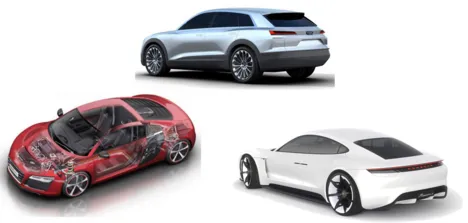Topology-Optimisation of electric powertrains for AWD-vehicles
Project completed - Contact: ftm(at)ftm.mw.tum.de

Despite all efforts to reduce fleet emissions and consumptions, SUVs enjoy continuously increasing popularity. Vehicles of this segment - but also other types of vehicles such as sports cars or real off-road vehicles - at a high share are equipped with all-wheel drive, although these probably are not required for most of the fields of real world application only a fraction of the operating time. The mechanical distribution of the drive power to all four wheels with conventional powertrains performs permanent losses by friction and extra weight. This leads to the question, whether losses caused by high user demands combined with very little effort in real world use can be decreased or even eliminated by the high variability of electrical AWD-topologies.
Electric powertrains do not necessarily require mechanical distribution, since in-stalling more than one electric motors is possible in contrast to conventional drivetrains. Thus a large number of combination of the number, type and arrangement of electric motors, gearboxes and torque distributions systems is imaginable. There already are studies that already identify preferable configurations in order to fulfill certain requirements. But those studies mostly are limited only on the investigation of longitudinal dynamic behavior - usually considering the trade-off between performance and fuel consumption.
In this approach different powertrain layouts very efficiently are to be simulated. The right choice concerning the level of detail is of decisive importance for the computational performance of the subsequent optimization. Then a holistic assessment of the concept’s properties is made. In addition to purely longitudinal dynamic observation, all customer-relevant properties influenced by the powertrain layout - especially lateral dynamics need to be evaluated. This enables the fully automatized evaluation of concepts right after the simulation. Thus multiple different powertrain layouts quickly can be evaluated. Finally, the process of simulation and evaluation can be used for optimization in order to find the best design for each vehicle category and a set of requirements. By comparing the optimized powertrain layouts with existing conventional AWD-vehicles the conclusion shall be drawn for all vehicle type categories if and to what extent electrical systems have advantages versus conventional ones in different vehicle classes.
Image sources: Audi, Porsche